Students must practice these TS Inter 1st Year Maths 1A Important Questions Chapter 3 Matrices to help strengthen their preparations for exams.
TS Inter 1st Year Maths 1A Matrices Important Questions
Very Short Answer Questions
Question 1.
Find the trace of A if A = \(\left[\begin{array}{rrr}
1 & 2 & -\frac{1}{2} \\
0 & -1 & 2 \\
-\frac{1}{2} & 2 & 1
\end{array}\right]\)
Solution:
The elements in the principal diagonal of A are 1, – 1, 1.
∴ Trace of A = 1 -1 + 1 = 1.
![]()
Question 2.
If \(A=\left[\begin{array}{ll}
1 & 2 \\
3 & 4
\end{array}\right], B=\left[\begin{array}{ll}
3 & 8 \\
7 & 2
\end{array}\right]\) and 2X+A=B then find X.
Solution:
2X + A= B ⇒ 2X = B – A

Question 3.
A certain bookshop has 10 dozen Chemistry books, 8 dozen Physics books, 10 dozen Economics books. Their selling prices are Rs. 80, Rs. 60 and Rs. 40 each respectively. Using matrix algebra, find the total value of the books in the shop.
Solution:
Number of books


= 120×80 +96×60+ 120×40
= 9600 + 5760 + 4800
= Rs. 20,160
Question 4.
If \(A=\left[\begin{array}{rrr}
2 & 3 & -1 \\
7 & 8 & 5
\end{array}\right] \text { and } B=\left[\begin{array}{rrr}
1 & 0 & 1 \\
2 & -4 & -1
\end{array}\right]\) then find A + B.
Solution :

Question 5.
If \(\left|\begin{array}{ccc}
x-1 & 2 & y-5 \\
z & 0 & 2 \\
1 & -1 & 1+a
\end{array}\right|=\left|\begin{array}{ccc}
1-x & 2 & -y \\
2 & 0 & 2 \\
1 & -1 & 1
\end{array}\right|\) then find the values of x, y, z and ‘a’.
Solution:
From the equality of matrices
x – 1=1 – x = 2x = 2 = x = 1
y – 5 = – y = 2y = 5 = y = \(\frac{5}{2}\) and z = 2,
Also 1 + a = 1 a = 0
![]()
Question 6.
If \(A=\left[\begin{array}{rr}
4 & -5 \\
-2 & 3
\end{array}\right]\) find -5A
Solution:
\(-5 A=-5\left[\begin{array}{rr}
4 & -5 \\
-2 & 3
\end{array}\right]=\left[\begin{array}{rr}
-20 & 25 \\
10 & -15
\end{array}\right]\)
Question 7.
Find the additive Inverse of A where
\(A=\left[\begin{array}{ccc}
i & 0 & 1 \\
0 & -i & 2 \\
-1 & 1 & 5
\end{array}\right]\)
Solution:
The additive inverse of A is – A
\(\text { i.e., }\left[\begin{array}{rrr}
-\mathrm{i} & 0 & -1 \\
0 & \mathrm{i} & -2 \\
1 & -1 & -5
\end{array}\right]\)
Question 8.
If \(A=\left[\begin{array}{rrr}
2 & 3 & 1 \\
6 & -1 & 5
\end{array}\right] \text { and } B=\left[\begin{array}{rrr}
1 & 2 & -1 \\
0 & -1 & 3
\end{array}\right]\) then find the matrix X such that A + B – X = 0. What is the order of the matrix?
Solution :
A + B – X = 0 = X = A + B

Question 9.
If \( A=\left[\begin{array}{lll}
0 & 1 & 2 \\
2 & 3 & 4 \\
4 & 5 & 6
\end{array}\right] \text { and } B=\left[\begin{array}{rrr}
1 & -2 & 0 \\
0 & 1 & -1 \\
-1 & 0 & 3
\end{array}\right]\) then find A – B and 4B – 3A.
Solution :

![]()
Question 10.
Two factories I and II produce three varieties of pens namely Gel, Ball, and Ink pens. The sale In rupees of these varieties of pens by both the factories in the month of September and October in a year are given by the following matrices A and B. September sales (In Rupees)
\(A=\left\{\begin{array}{ccc}
\text { Gel } & \text { Ball } & \text { Ink } \\
1000 & 2000 & 3000 \\
5000 & 3000 & 1000
\end{array}\right\} \text { Factory I }\)
October sales (in Rupees)
\(B=\left\{\begin{array}{ccc}
\text { Gel } & \text { Ball } & \text { Ink } \\
500 & 1000 & 600 \\
2000 & 1000 & 1000
\end{array}\right\} \text { Factory I }\)
Solution:
i) Find the combined sales in September and October for each factory in each variety.
ii) Find the decrease in sales from September to October.
Solution:
i) Combined sales in September and October for each factory in each variety is
\(A+B=\left\{\begin{array}{ccc}
\text { Gel } & \text { Ball } & \text { Ink } \\
1500 & 3000 & 3600 \\
7000 & 4000 & 2000
\end{array}\right\} \text { Factory I }\)
ii) Decrease in sales from September to October is .
\(\mathrm{A}-\mathrm{B}=\left\{\begin{array}{ccc}
\text { Gel } & \text { Ball } & \text { Ink } \\
500 & 1000 & 2400 \\
3000 & 2000 & 0
\end{array}\right\} \begin{aligned}
& \text { Factory I } \\
& \text { Factory II }
\end{aligned}\)
![]()
Question 11.
Construct a 3 x 2 matrix whose elements are defined by \(a_{i j}=\frac{1}{2}|i-3 j|\).
Solution:
The matrix to be constructed is

Question 12.
If \(A=\left[\begin{array}{lll}
0 & 1 & 2 \\
1 & 2 & 3 \\
2 & 3 & 4
\end{array}\right] \text { and } B=\left[\begin{array}{rr}
1 & -2 \\
-1 & 0 \\
2 & -1
\end{array}\right]\) then find AB and BA.
Solution:
Since the number of columns of A is equal to number of rows of B, AB is defined and

Now the number of columns of B is not equal to the number of rows A, BA is not defined.
Question 13.
If \(A=\left[\begin{array}{rrr}
1 & -2 & 4 \\
2 & 3 & -1 \\
-3 & 1 & 2
\end{array}\right] \text { and } B=\left[\begin{array}{rrr}
1 & 0 & 2 \\
0 & 1 & 2 \\
1 & 2 & 0
\end{array}\right]\) then examine whether A and B commute with respect to multiplication of matrices.
Solution:
The two matrices A and B are square matrices of order 3. Hence AB and BA are both defined.
\(A B=\left[\begin{array}{rrr}
1 & -2 & 3 \\
2 & 3 & -1 \\
-3 & 1 & 2
\end{array}\right]\left[\begin{array}{rrr}
1 & 0 & 2 \\
0 & 1 & 2 \\
1 & 2 & 0
\end{array}\right]\)

∴ AB ≠ BA and hence A, B do not commute with respect to multiplication.
Question 14.
If \(A=\left[\begin{array}{rrr}
-2 & 1 & 0 \\
3 & 4 & -5
\end{array}\right] \text { and } B=\left[\begin{array}{rr}
1 & 2 \\
4 & 3 \\
-1 & 5
\end{array}\right]\) then find A +B’
Solution:

Question 15.
If \(A=\left[\begin{array}{rrr}
0 & 4 & -2 \\
-4 & 0 & 8 \\
2 & -8 & x
\end{array}\right]\) is a skew symmetric
Solution:

Since A is a skew symmetric matrix, A’ = – A
⇒ 2x = 0 ⇒ x = 0
Question 16.
If ω is a complex cube root of unity show that \(\left|\begin{array}{ccc}
1 & \omega & \omega^2 \\
\omega & \omega^2 & 1 \\
\omega^2 & 1 & \omega
\end{array}\right|=0\)
Solution:
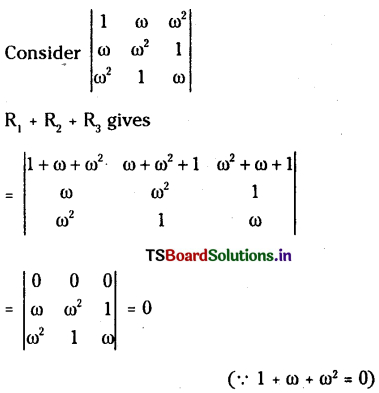
![]()
Question 17.
Find the adjoint and inverse of the matrix
\(A=\left[\begin{array}{cc}
1 & 2 \\
3 & -5
\end{array}\right]\)
Solution:

Question 18.
Find whether the following 8ystem of linear homogeneous equations has a non-trivial solution.
X – y + z = 0
x+2y – z = 0
Zx+y+3z = 0
Solution:
The coefficient matrix is \(A=\left[\begin{array}{ccc}
1 & -1 & 1 \\
1 & 2 & -1 \\
2 & 1 & 3
\end{array}\right]\)
det A= 1(6+ 1)+ 1(3+2) + 1(1 – 4)
=7 +5 – 3 = 9 ≠ 0
Hence the system has the trivial solution x = y = z = 0 only.
![]()
Question 19.
If A is an invertible matrix then A’ is also invertible and \(\left(A^{\prime}\right)^{-1}=\left(A^{-1}\right)^{\prime}\)
Solution:

Question 20.
If A and B are two invertible matrices of same type then AB is also invertible and \((A B)^{-1}=B^{-1} A^{-1}\)
Solution:

Short Answer Questions
Question 1.
If \(A=\left[\begin{array}{cc}
\cos \theta & \sin \theta \\
-\sin \theta & \cos \theta
\end{array}\right]\) then show that for all the positive integers n \(A^{\mathbf{n}}=\left[\begin{array}{cc}
\cos n \theta & \sin n \theta \\
-\sin n \theta & \cos n \theta
\end{array}\right]\)
Solution:
We use the process of mathematical induction for proving this result statement

∴The statement P(n) is true for n = k + 1.
Hence by mathematical induction P(n) is true for all positive integral values of n.
![]()
Question 2.
If \(A=\left[\begin{array}{lll}
1 & 2 & 2 \\
2 & 1 & 2 \\
2 & 2 & 1
\end{array}\right]\) then show that A2 – 4A – 5I = 0
Solution:

Question 3.
For any n x n matrix A; Prove that A can be uniquely expressed as a sum of a symmetric matrix and a skew-symmetric matrix.
Solution:
For a square matrix of order n.
A + A’ is symmetric and A – A’ is a skew-symmetric matrix and
\(\mathrm{A}=\frac{1}{2}\left(\mathrm{~A}+\mathrm{A}^{\prime}\right)+\frac{1}{2}\left(\mathrm{~A}-\mathrm{A}^{\prime}\right)\)
Let B be a symmetric matrix and C be a skew symmetric matrix such that
A = B + C

![]()
Question 4.
Show that \(\left|\begin{array}{ccc}
1 & a & a^2 \\
1 & b & b^2 \\
1 & c & c^2
\end{array}\right|\) = (a – b) (b – c) (c -a)
Solution:

Question 5.
Show that \(\left|\begin{array}{ccc}
\mathbf{a}-\mathbf{b}-\mathbf{c} & 2 \mathbf{a} & 2 \mathbf{a} \\
2 \mathbf{b} & \mathbf{b}-\mathbf{c}-\mathbf{a} & 2 \mathbf{b} \\
2 \mathbf{c} & 2 \mathbf{c} & \mathbf{c}-\mathbf{a}-\mathbf{b}
\end{array}\right|\) = (a+ b+c)2
Solution:

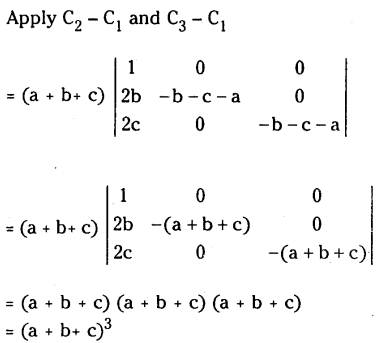
Question 6.
Find the rank of \(A=\left[\begin{array}{lll}
0 & 1 & 2 \\
1 & 2 & 3 \\
3 & 2 & 1
\end{array}\right]\) using elementary transformations.
Solution:

Since there are two non-zero rows in above matrix the rank of the given matrix ρ(A) = 2.
![]()
Question 7.
Find the rank \( A=\left[\begin{array}{rrrr}
1 & 2 & 0 & -1 \\
3 & 4 & 1 & 2 \\
-2 & 3 & 2 & 5
\end{array}\right]\) using elementary transformations.
Solution:

Since these are 3 non-zero rows in above reduced form, the rank of the given matrix ρ(A) = 3.
Question 8.
Show that matrix multiplication is associative.
Solution:

∴ (AB)C = A(BC); Hence matrix multiplication is associative.
Long Answer Questions
Question 1.
Without expanding the determinant show that

Solution:
LHS = Use R1 + (R2 + R3)
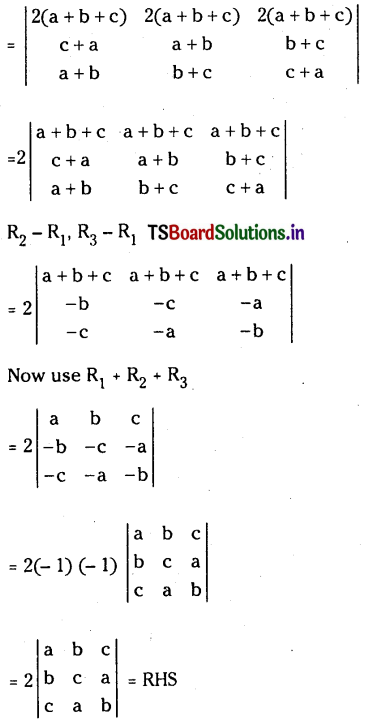
Question 2.
Show that \(\left|\begin{array}{ccc}
1 & a^2 & a^3 \\
1 & b^2 & b^3 \\
1 & c^2 & c^3
\end{array}\right|\) = (a – b) (b – c) (c – a) (ab bc + ca).
Solution:
Use R2 – R1, R3 – R1 on LHS

![]()
Question 3.
Find the value of x if

Solution:

Question 4.
Find the adjoint and the inverse of the matrix A = \(\left[\begin{array}{lll}
1 & 3 & 3 \\
1 & 4 & 3 \\
1 & 3 & 4
\end{array}\right]\)
Solution :

Question 5.
Show that \( A=\left[\begin{array}{lll}
1 & 2 & 1 \\
3 & 2 & 3 \\
1 & 1 & 2
\end{array}\right]\) is non-singular and find A-1
Solution:


Question 6.
Apply the test of rank to examine whether the following equations are consistent 2x-y+3z = 8, -x+2y+z=4, 3x+y-4Z = 0 and if consistent find the complete solution.
Solution:

Now rank (A) = rank (AB) = 3
∴ The system has unique solution From above we have so
– x + 2y + z = 4 ……………………… (1)
3y + 5z = 16 ……………………… (2)
z = 2 ……………………… (3)
3y+10 = 16 ⇒ 3y = 6 ⇒ y = 2
∴ From (1), – x + 4 + 2 = 4
⇒ x = 2
∴ x = 2, y= 2, z = 2 is the solution.
![]()
Question 7.
Show that the following system of equations is consistent and solve it completely
x + y + z = 3, 2x +2y – z = 3, x + y – z = 1.
Solution :

Here ρ(A) = 2 and ρ(AB) = 2.
∴ The system is consistent and has infinitely many solutions.
From the above-reduced form
x+y+z=3
z= 1
∴ x + y = 2
Hence x = k, y = 2 – k, z = 1, k ∈ R is a solution set.
![]()
Question 8.
Solve the following slmultaneou8 linear equations by using Cramer’s rule.
3x+4y+5z =18
2x- y+8z = 13
5x – 2y+ 7z = 20
Solution :

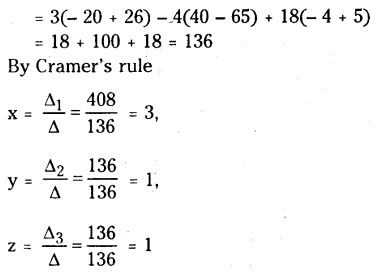
∴ The solution of the given system of equations is x = 3, y = 1, z = 1.
Question 9.
Solve 3x+3y+5z=18
2x – y + 8z = 13 .
and 5x – 2y+7z=20 by using matrix inversion method.
Solution:

![]()
Question 10.
Solve the following equations by Gauss Jordan method.
3x+4y+5z=18
2x – y+8z= 13
5x – 2y+7z= 20
Solution:
The augmented matrix is

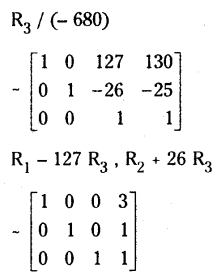
ρ(A) = ρ(AB) = 3; and unique soLution exists given by x = 3, y = 1 and z = 1.
Question 11.
Solve the following system of equations by Gauss Jordan method
x+y+z=3,
2x+2y – z=3,
x+y – z=1
Solution:
Augmented matrix of the system is

Here ρ(A) 2, ρ(AB) = 2.
So the system is consistent and has infinite number of solutions.
∴ x + y + z = 3, – 3z = – 3 ⇒ z = 1
∴ x + y = z
Suppose x = k, then y = 2 – k and solution set
= (x = ky = 2 – k, z= 1 where k ∈ R)
Question 12.
By using Gauss Jordan method show that the following system has no solution
2x+4y – z= o,
x + 2y + 2z = 5,
3x+ 6y – 7z = 2.
Solution:
Augmented matrix of the system is
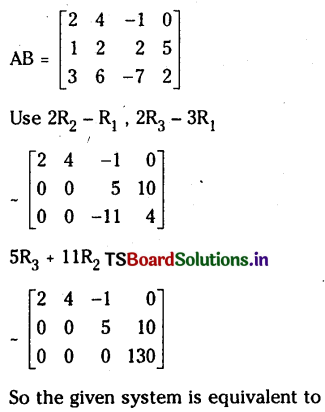
2x+4y – z=0 ………………. (1)
5z = 10 = z = 2 ……………….. (2)
and 0.x + 0.y + 0.z = 130 ………………. (3)
Clearly no value of x, y, z satisfy (3).
∴ Given system of equations has no solution.
![]()
Question 13.
Find the non-trivial solutions, if any, for the following system of equations.
2x + 5y + 6z = 0
x – 3y – 8z = 0
3x+y – 4z = 0
Solution:
Coefficient matrix is

Since two rows are identical, ρ(A) = 2.
Hence the system has a non-trivial solution
x – 3y + 8z = 0 …………….. (1)
y + 2z = 0 …………. (2)
Suppose z = k, then y – 2k and
x = 3y – 8z = – 6k – 8k = – 14k for k ≠ 0
so we obtain non-trivial solutions.
Question 14.
If A is a non-singular matrix then prove that \(A^{-1}=\frac{1}{\operatorname{det} A}(\operatorname{Adj} A)\)
Solution:

